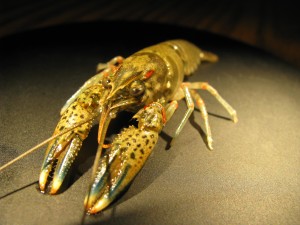Research in the Aquatic Ecology and Astacology Lab involves a variety of aquatic biota in riverine, stream, floodplain, lake, wetland, and estuarine habitats throughout Louisiana. Below are some examples of previous and ongoing research.

Distribution and life history of Louisiana crayfishes
Most people in Louisiana are familiar with our two commercially important crayfishes, the red swamp crawfish Procambarus clarkii and the southern white river crawfish Procambarus zonangulus. However, most are unaware that Louisiana has approximately 39 species of crayfish within seven genera. I am attempting to fill in gaps and update our current knowledge on the distribution, life history, and ecology of crayfishes throughout Louisiana.
 Stock assessment of crayfish in the eastern Atchafalaya River Basin
Stock assessment of crayfish in the eastern Atchafalaya River Basin
Stock assessments are vital in modern fisheries management to monitor past and current status on populations including population size and structure, and the potential responses of the fishery to future management decisions. However, there have not been extensive stock assessments for the crayfish fishery in the Atchafalaya River Basin (ARB). We are working with The Nature Conservancy and local crayfish processors to obtain a stock assessment for crayfish in the eastern ARB. The results obtained from this project will provide the first empirical-based, fisheries-dependent large-scale stock assessments for crayfish in the ARB.
 Effect of hydrologic restoration activities on P. clarkii population characteristics in the Atchafalaya River Basin
Effect of hydrologic restoration activities on P. clarkii population characteristics in the Atchafalaya River Basin
Hydrologic restoration activities planned for The Nature Conservancy’s Atchafalaya Basin Preserve are aimed to improve flow patterns and water quality and ultimately reduce the extent, severity, and duration of hypoxia in restored areas. We are working with TNC to examine P. clarkii population characteristics and physiological indices before and after these hydrologic restoration projects. The information obtained will be used to evaluate the effect of restored water quality on P. clarkii populations and can be incorporated into future conservation and restoration decision activities.
 Biotic and abiotic effects on Procambarus clarkii in the Atchafalaya River Basin
Biotic and abiotic effects on Procambarus clarkii in the Atchafalaya River Basin
Over 90% of the wild crayfish harvest in Louisiana comes from the Atchafalaya River Basin, however, little research has examined the ecology of P. clarkii and the environmental factors that structure crayfish populations and harvests in this system. My research examines how various biotic and abiotic factors (e.g., water quality, habitat characteristics, density) influence crayfish harvests and population structure.

Effects of environmental hypoxia on P. clarkii population characteristics
Spatially extensive and temporally persistent hypoxia in the ARB is associated with the annual floodpulse and floodplain inundation. Crayfish and other aquatic biota are subjected to hypoxic conditions that can last for several weeks to months in many areas of the ARB. I am examining crayfish population responses to environmental hypoxia by monitoring and comparing populations sampled from hypoxic and normoxic habitats throughout the ARB.

Physiological biomarkers of hypoxic stress in P. clarkii
Crayfish frequently encounter hypoxic conditions in aquatic and/or burrow habitats. Physical responses by crayfish are often the result of physiological and behavioral responses to endure sub-optimal oxygen conditions. My research investigates and quantifies several physiological biomarkers (hemolymph lactate, protein, and glucose concentrations) of hypoxic stress in crayfish from both field and laboratory experiments.